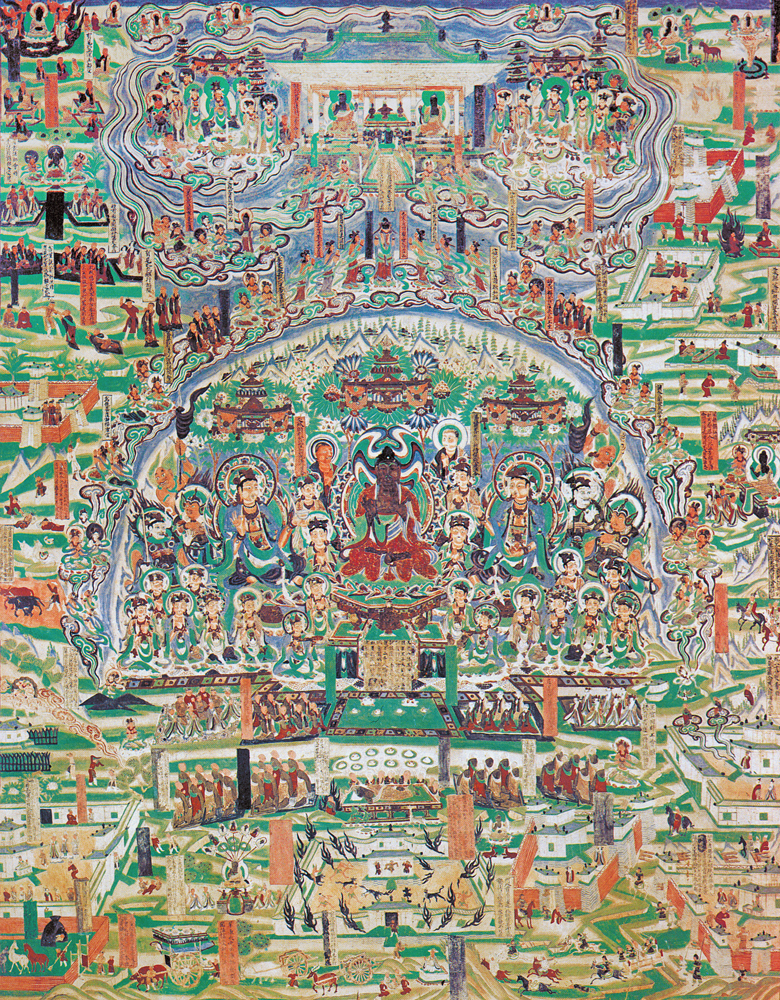This study series focuses on Nichiren Daishonin’s disciples, who faced challenges we can relate to today, and his enduring encouragement to them that we can apply to dynamically transform our lives.
While study and interpretation of the Lotus Sutra’s imagery date back millennia, Nichiren Daishonin made clear that the sutra’s fundamental message is to praise and reveal our magnificent potential as human beings.
His letter “On the Treasure Tower” offers a great example of this point. In it, he answers a question about the meaning of the treasure tower that arises from the earth at the start of the Lotus Sutra’s Ceremony in the Air.[1]
The question came from Abutsu-bo, a Sado Island resident who had been a staunch Pure Land believer, but who converted to Nichiren’s teaching after being moved by his character. While in exile on Sado, Nichiren received support from Abutsu-bo and his wife, Sennichi, and many others dedicated to protecting him and practicing his teachings with a strong seeking spirit.
In response to Abutsu-bo’s question, Nichiren explains the treasure tower’s significance, relating it directly to the lives of his disciples.
Knowing Our Potential and Worth
The Ceremony in the Air begins with the treasure tower—adorned with shining jewels and estimated to be around one-third the earth’s diameter—emerging from the ground and suspended in the air.
Given the image of a colossal, glittering tower arising from the ground and floating mid-air, we can see why Abutsu-bo asked about its significance. In his response, Nichiren teaches that this resplendent tower is none other than Abutsu-bo himself and writes:
In the Latter Day of the Law, no treasure tower exists other than the figures of the men and women who embrace the Lotus Sutra. It follows, therefore, that whether eminent or humble, high or low, those who chant Nam-myoho-renge-kyo are themselves the treasure tower, and, likewise, are themselves the Thus Come One Many Treasures. (“On the Treasure Tower,” The Writings of Nichiren Daishonin, vol. 1, p. 299)
Nichiren’s statement “whether eminent or humble, high or low” means that every person who chants Nam-myoho-renge-kyo and spreads the Mystic Law, regardless of gender, ethnic background or social position, is a precious treasure tower.
For us, to perceive the treasure tower within our own lives means to become aware of our tremendous potential and worth and, at the same time, to respect the lives and potential of all others.
We Are Noble Treasure Towers
In the Lotus Sutra’s Ceremony in the Air, Many Treasures is the Buddha seated in the treasure tower next to Shakyamuni Buddha. In the remote past, he vowed to appear whenever the Lotus Sutra is preached to attest to its validity.
When we, through sincere Buddhist practice, cause the treasure tower of our Buddha nature within us to shine, then, like the Buddha Many Treasures, we demonstrate to others the incredible power and validity of the Mystic Law.
However excellent a teaching may be, without people who practice it and prove its effectiveness in their lives and actions, others will not understand it, and the teaching will not spread.
Ikeda Sensei offers the following guidance:
This passage … refers to “the figures of the men and women who embrace the Lotus Sutra.” Here, the word figures encompasses such things as our outward form and actions. It does not refer to some abstract or ideal, but to the concrete reality of our lives as we go about our daily affairs here and now.
Nichiren declares that there is no treasure tower other than real, living human beings. The lives of those who embrace faith in the Gohonzon, chant Nam-myoho-renge-kyo, and propagate Nichiren Buddhism shine moment after moment as entities of the Mystic Law. We ordinary people, while undergoing the joys and sufferings of this world, are each an infinitely noble treasure tower, just as we are. (The Teachings for Victory, vol. 3, p. 122)
People come to understand the Soka Gakkai and Nichiren Buddhism through the integrity and examples of its members. As we greet others with bright, friendly smiles and act responsibly, respectfully and sincerely each day, we demonstrate the greatness of this Buddhism and open the way for kosen-rufu. We embody the ideals of Soka humanism in how we live and behave.
What is crucial, then, is that by chanting earnestly to the Gohonzon, we open and reveal the world of Buddhahood within us and shine as treasure towers in our families, communities and workplaces.
The brilliance we develop through faith will stimulate the Buddha nature in others and lead them to shine with us as treasure towers.
—Prepared by the SGI-USA study department
References
- Ceremony in the Air: One of the three assemblies described in the Lotus Sutra, in which the entire gathering is suspended in space above the saha world. It extends from “The Emergence of the Treasure Tower,” the 11th chapter, to “Entrustment,” the 22nd chapter. The heart of this ceremony is the revelation of the Buddha’s original enlightenment in the remote past and the transfer of the sutra’s essence to the Bodhisattvas of the Earth. ↩︎
You are reading {{ meterCount }} of {{ meterMax }} free premium articles

